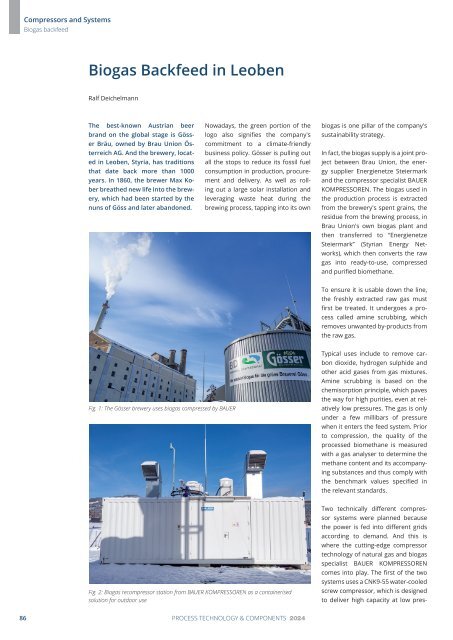PuK - Process Technology & Components 2024
A technical trade magazine with a history of more than 60 years.
A technical trade magazine with a history of more than 60 years.
You also want an ePaper? Increase the reach of your titles
YUMPU automatically turns print PDFs into web optimized ePapers that Google loves.
Compressors and Systems<br />
Biogas backfeed<br />
Biogas Backfeed in Leoben<br />
Ralf Deichelmann<br />
The best-known Austrian beer<br />
brand on the global stage is Gösser<br />
Bräu, owned by Brau Union Österreich<br />
AG. And the brewery, located<br />
in Leoben, Styria, has traditions<br />
that date back more than 1000<br />
years. In 1860, the brewer Max Kober<br />
breathed new life into the brewery,<br />
which had been started by the<br />
nuns of Göss and later abandoned.<br />
Nowadays, the green portion of the<br />
logo also signifies the company's<br />
commitment to a climate-friendly<br />
business policy. Gösser is pulling out<br />
all the stops to reduce its fossil fuel<br />
consumption in production, procurement<br />
and delivery. As well as rolling<br />
out a large solar installation and<br />
lever aging waste heat during the<br />
brewing process, tapping into its own<br />
biogas is one pillar of the company's<br />
sustainability strategy.<br />
In fact, the biogas supply is a joint project<br />
between Brau Union, the energy<br />
supplier Energienetze Steiermark<br />
and the compressor specialist BAUER<br />
KOMPRESSOREN. The biogas used in<br />
the production process is extracted<br />
from the brewery's spent grains, the<br />
residue from the brewing process, in<br />
Brau Union's own bio gas plant and<br />
then transferred to “Energienetze<br />
Steiermark” (Styrian Energy Networks),<br />
which then converts the raw<br />
gas into ready-to-use, compressed<br />
and purified biomethane.<br />
To ensure it is usable down the line,<br />
the freshly extracted raw gas must<br />
first be treated. It undergoes a process<br />
called amine scrubbing, which<br />
removes unwanted by-products from<br />
the raw gas.<br />
Fig. 1: The Gösser brewery uses biogas compressed by BAUER<br />
Typical uses include to remove carbon<br />
dioxide, hydrogen sulphide and<br />
other acid gases from gas mixtures.<br />
Amine scrubbing is based on the<br />
chemisorption principle, which paves<br />
the way for high purities, even at relatively<br />
low pressures. The gas is only<br />
under a few millibars of pressure<br />
when it enters the feed system. Prior<br />
to compression, the quality of the<br />
processed biomethane is measured<br />
with a gas analyser to determine the<br />
methane content and its accompanying<br />
substances and thus comply with<br />
the benchmark values specified in<br />
the relevant standards.<br />
Fig. 2: Biogas recompressor station from BAUER KOMPRESSOREN as a containerised<br />
solution for outdoor use<br />
Two technically different compressor<br />
systems were planned because<br />
the power is fed into different grids<br />
according to demand. And this is<br />
where the cutting-edge compressor<br />
technolo gy of natural gas and biogas<br />
specialist BAUER KOMPRESSOREN<br />
comes into play. The first of the two<br />
systems uses a CNK9-55 water-cooled<br />
screw compressor, which is designed<br />
to deliver high capacity at low pres-<br />
86 PROCESS TECHNOLOGY & COMPONENTS <strong>2024</strong>

















